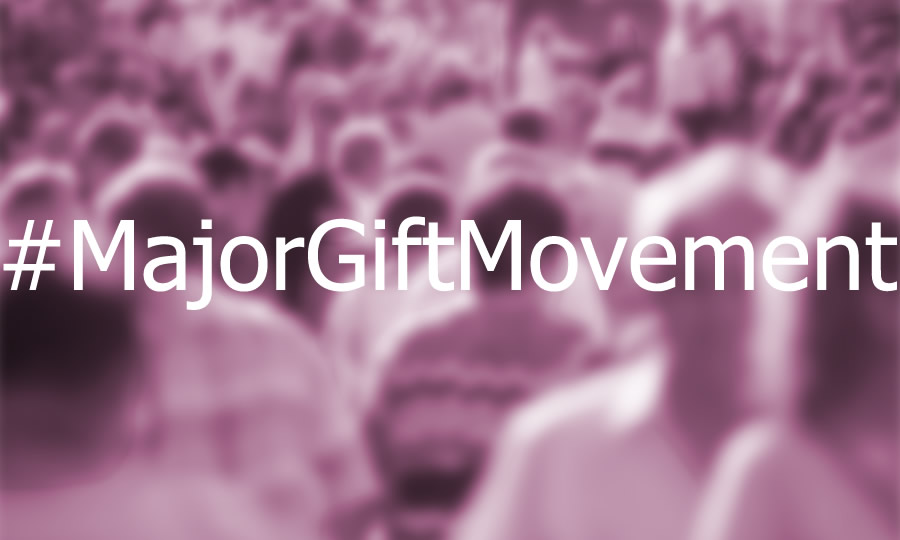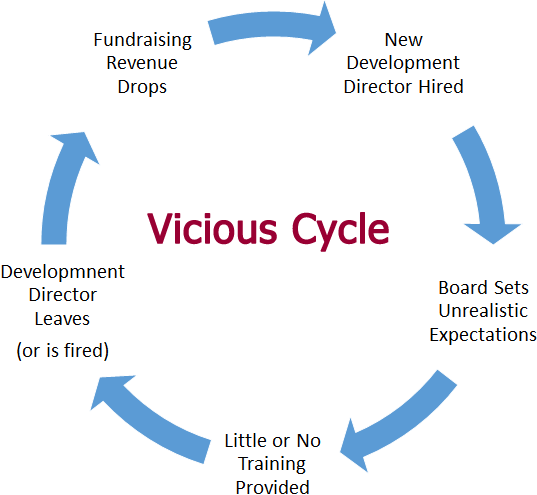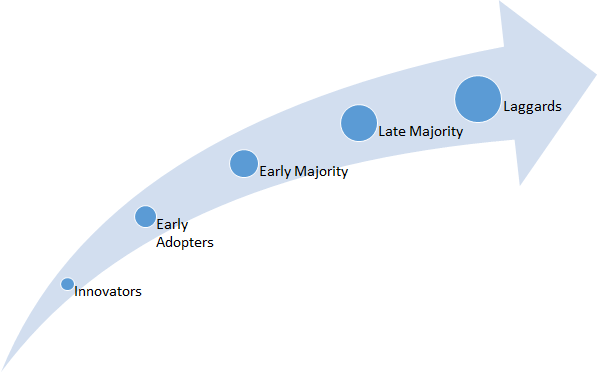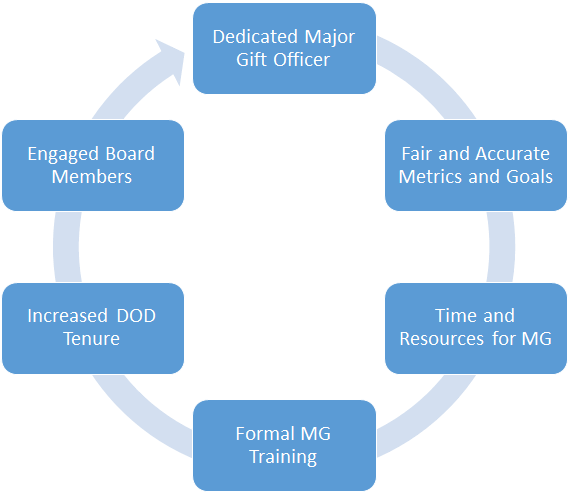
According to a recent survey, the average tenure of development professionals is just 18 months. Other sources say it’s only 16 months.
Either way, the extremely short duration is bad for organizations, bad for development professionals, and bad for donors.
As a consultant, I frequently review development resumes, and it never ceases to amaze me when they are crammed with evidence of job hopping — one year here, two years there — sometimes for as many as five or six jobs in a row.
The Chicken and the Egg Question
Does the Development Director leave because of unrealistic expectations, low pay, lack of board support? Do they get fired for not achieving success quickly enough? (And, who is setting the expectations?)
This is important, because I’m afraid development professionals are caught in a vicious cycle with regard to overall fundraising, and more specifically, with raising major gifts.
It’s a vicious cycle…
It’s often perceived as easier and quicker to raise funds from grant writing and fundraising events, which is why new development directors find themselves trapped within a stream of never ending deadlines and impending events.

…with disastrous consequences.
When a development director leaves, it often takes many months to replace them. This leaves remaining staff scrambling to complete necessary fundraising tasks, and many responsibilities fall through the cracks. It also costs money to find, hire, and train a new staff member.
Probably the most important negative effect is the damaged relationships with donors. The new development director will need to spend months or even years building relationships from scratch.
Bad for organizations, bad for donors, bad for professionals.
Job hopping is also bad for development professionals. Searching for a job and starting a new one is never easy. It’s bad for your career to have multiple jobs in a short period of time. Not to mention the fact that you can’t get good development experience constantly starting new jobs from scratch.
Again — bad for organizations, bad for donors, bad for development professionals.
If you want to stop this vicious cycle, and are committed to helping development professionals successfully raise major gifts at all types of organizations, I hope you’ll join the #MajorGiftMovement.
It’s Time to Fix a Broken System
The #MajorGiftMovement is about moving nonprofits from heavy dependence on grant writing and event planning and into the world of individual giving and major gifts — a world with more benefits for all involved.
The problem with grant writing and event planning is that they are labor intensive and expensive! The cost to raise $1 is approximately five times greater for fundraising events than it is for raising major gifts.
[bctt tweet=”Investing dollars in major gifts is a good choice with a large ROI. #MajorGiftMovement”]
Major Gifts is one of the least expensive forms of fundraising, in terms of cost to raise a dollar, and yet, most nonprofits remain heavily invested in fundraising events and grant writing.
An unsettling fact about most nonprofits today…
What truly concerns me (and should concern you too) is that most nonprofits have staff members who are paid to focus their time and attention on grant writing and event planning, and only a tiny fraction of nonprofit organizations have staff members who are paid to focus on raising major gifts.
How’s that for backwards?
Be a Trendsetter — Ride the Wave
Every movement or trend has trendsetters, who are the innovators and early adopters. I’m inviting you to be part of the initial group that sets the trend.

By supporting the #MajorGiftMovement NOW, while it’s in its infancy, you’ll be an early adopter. And early adopters of any new movement are the ones who reap the most benefits.
And it pays to be an early adopter.
You’ll be among the first hired, highest paid, and most in-demand fundraisers.
You’ll help create a world where every organization has a major gift officer and all organizations are able to raise major gifts and accomplish their missions in bigger and more robust ways.
The time is NOW for nonprofit leaders to realize that major gift officers and development directors are most successful when board and staff members are using accurate metrics and have realistic goals.
Ok, I’m in! What should I do?
If you’re ready to become part of the #MajorGiftMovement and help fix the broken fundraising system, here’s what you need to do:
- Start the conversation at your organization about prioritizing raising major gifts.
- Set aside time and resources dedicated to raising major gifts this year.
- Develop accurate metrics to measure your major gifts program and set clear expectations and goals (look for this in an upcoming post).
- Make a plan to hire your first major gifts officer in the next 12 to 24 months.
- Provide adequate major gift training to all development staff and board members, thereby increasing the average tenure of development professionals to more than two years.
- Help increase awareness about the #MajorGiftMovement with a tweet, Facebook mention or a social share.
Vision of a Successful #MajorGiftMovement
So what would the world look like if the #MajorGiftMovement is a success?

Nonprofits have dedicated major gift officers.
Every organization will have a dedicated major gift officer who is judged by fair and accurate goals and metrics.
Development professionals are more valuable.
Organizations will provide time and resources for raising major gifts, including formal major gift training. As a result, average tenure increases to five years or more and board members are increasingly involved and engaged.
The vicious cycle is over.
Development professionals remain at their nonprofits for several years, being able to foster deeper and longer-lasting relationships with top donors. It’s win-win, all the way around.
Join the #MajorGiftMovement and EVERYONE wins — organizations, donors, and you.
[bctt tweet=”I’m joining the #MajorGiftMovement to modernize our nonprofit and improve fundraising for all!”]
Keep up with the #MajorGiftMovement!
The #MajorGiftMovement is just getting started. The best way to keep up with how it’s evolving and changing the face of fundraising is to join my list. You’ll also get two free eBooks to help your nonprofit succeed.
Questions about the movement? Suggestions? Leave a comment below.

Training should not be limited to the DOD. Board training is critical given how important their role is in fundraising. Team building between board and the development team so they can work together collaboratively with the same overall objectives in mind and shared accountability.
You’re absolutely right. A big part of what I do as a consultant is board training. Thanks for highlighting that point.
It’s about time someone — like YOU — started a #majorgiftmovement. Unlike most things, a serious major gift movement that gets people over their fear of asking and propels them to ask and give, has the potential to change organizations, communities, and really… the world!
Bravo Amy. I’m happy to help!
Thank you for your kind words, Andrea! It’s going to take a lot of hard working people! We’re all in this together.
One word: Yes. And two more: About time. Thank you for leading the way, Amy. Excited to watch this movement grow and change our sector for the better.
Thanks, Shanon! So happy to have you on board.
High employee turnover rates are indeed a problem for major gift efforts. However, the trouble does not stop there. High turnover rates cause a great number of problems for nonprofit organizations. Unfortunately, the issue of high turnover rates has been one that has been discussed since I entered the profession over three decades ago. Since that time, the sector has done virtually nothing to solve the problem. While I appreciate your focus on the issue, I’m not convinced the nonprofit sector will address the problem of employee turnover anytime soon. It should, but it likely won’t. Nevertheless, it remains important to keep shining a spotlight on the issue; so, thank you!
Thanks for your thoughts, Michael. Since we agree that turnover is such a problem, it’s important to keep working on it. I hope this rejuvenates the conversation.
Nice work Amy! One more layer: A lot of development directors leave because they expect the board to be more directly involved in fundraising, and they blame a lack of board engagement. Meanwhile, the board expects development staff to raise money so they don’t have to. There’s a tendency for each side to blame the other.
For me, the definition of a successful development director is someone who gets OTHER PEOPLE (board, CEO, volunteers, non-fundraising staff) involved in fundraising, and facilitates their participation.
Yes, the DD needs to get out of the office and meet with donors — a lot more often. Thank you for ringing this bell loudly and forcefully. But the deeper work is building a culture of fundraising where everyone is involved in identifying, engaging, asking, and thanking donors. Then, when the DD leaves — and people do change jobs — the culture is in place to continue effective donor relations.
This is brilliant Amy – well done! I’m in!
I applaud your taking this stand. Very needed. Thank you.
Well said! I want to forward it to my past employers and start the conversation with my new non-profit. I have been here 6 weeks now and think it’s a perfect time for a conversation!
Hooray!